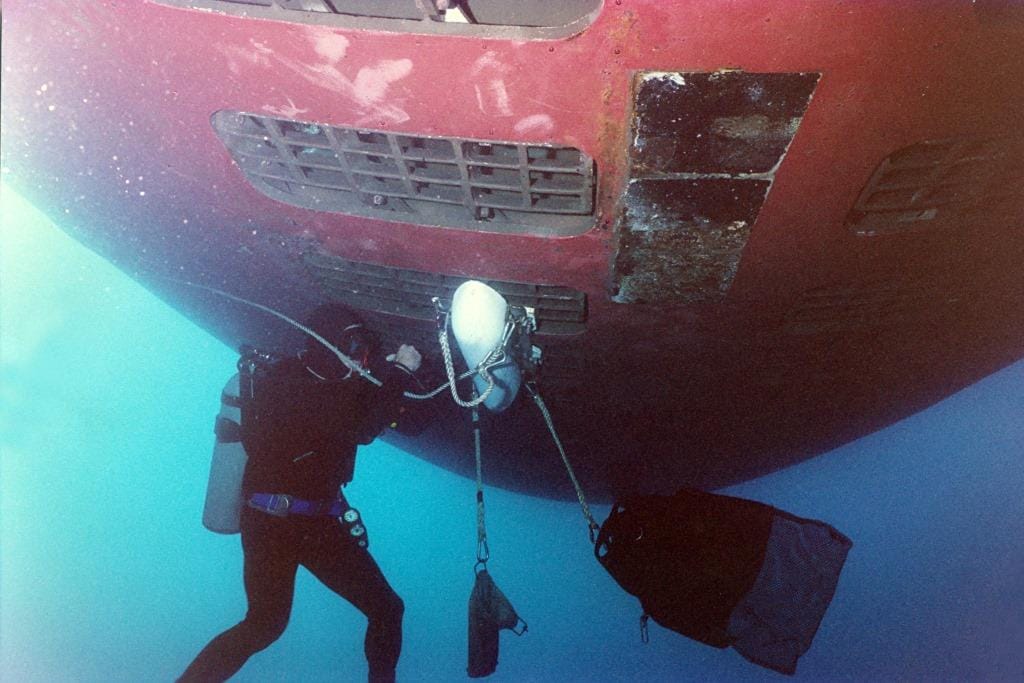ECHOES OF THE SANTA CRUZ ACOUSTIC RANGE FACILITY WEBINAR │A Zoom presentation by Dave Schiefen, Richard Hegeman and Lloyd Sorensen
Where: Santa Barbara Maritime Museum, 113 Harbor Way, Santa Barbara (online)
When: Thursday, May 20, 2021 at 7:00pm
Cost: Free, but registration is required. Donations welcome.
Sponsored by: Marie L Morrisroe
Register Now Via Zoom
The Santa Cruz Acoustic Range Facility (SCARF) was designed, built, installed, operated, and maintained by General Motors Defense Research Lab, Sea Operations from 1966 – 1982. The U.S. Navy took ownership of the range in 1982 at which time it was operated and maintained by Goleta-based MariPro, Inc. until it was decommissioned in 1990.
On Thursday, May 20 at 7pm, three men from Santa Barbara–Dave Schiefen, Richard Hegeman and Lloyd Sorensen—who were all involved with the SCARF program from day one until its decommissioning, will present a narrated slide show covering the history, development, installation, and operation of the SCARF facility.
What was SCARF and What Kind of Work Did it Do?
The onshore facility was located on the south side of Santa Cruz Island on land leased from the Santa Cruz Island Company. SCARF supported hundreds of U.S. Navy development and test programs, many of them classified.

Submarines protecting our national security must deploy with secrecy and operate undetected. To provide stealth during a mission, accurate measurement of sounds radiated by a submarine is essential. Noise generated from a submarine radiates from speed, depth, power plant operations, propeller cavitation and hydrodynamic noise created by hull vibrations. Using sub-sea hydrophones, the primary SCARF mission was to support radiated noise measurement for underway-surface ships and submarines at all speeds and depths.
Bottom-mounted sensor arrays in 4000 feet of water tracked submarine and surface ship movements over the range. As submarines transited by the vertical string of hydrophones, noise measurement information was gathered. Underwater cables transmitted the information to the shore station, and an Underwater Communications System (UQC) allowed the shore station to communicate with the submarines. This monitoring was vital in recognizing submarines’ vulnerabilities and recommending corrective actions to reduce radiated noise.
The entire shore facility and its in-water system were removed in 1990, and the area was returned to its natural state.
The Speakers
Dave Schiefen is a native Santa Barbarian. He graduated from the California Maritime Academy with a B.S. degree in Marine Engineering and received a Coast Guard 3rd Engineer Marine License for steam and diesel ships of any horsepower. He began his career at the General Motors Defense Research Lab (DRL) sea operations department in Goleta, CA, in 1961, and was involved in the development and operation of the SCARF range. At DRL he worked as a ship’s engineer, submersible pilot, diver, installation director and ocean engineering manager. In 1982, he and 13 other men, including Mr. Sorensen and Mr. Hegeman, left GM to open MariPro Inc., where they took over operations of the SCARF range until 1990. He retired in 2002.
Richard Hegeman also graduated from the California Maritime Academy with a B. S. degree in Marine Engineering and a Coast Guard License as a 3rd Assistant Engineer on Steam and Diesel ships of any horsepower. He was commissioned in the Naval Reserve as an Ensign and sailed with the Merchant Marine and the US Navy for two and half years before joining the Defense Research Lab (DRL) in Goleta, CA, in late 1962. At DRL he was assigned as an Engineer onboard the Research Vessel SWAN and trained as a diver. In 1964, he was part of the team for the start of the SCARF project and supported the program until its decommissioning in 1990. During his career Mr. Hegeman made over 3,000 dives in support of company projects, working in eight countries, and on 40 islands around the world before he retired from MariPro in 1999.
Lloyd Sorensen graduated from the California Maritime Academy with a B.S. Degree in Marine Engineering, with a U.S. Coast Guard Third Assistant License for Steam or Motor Vessels of any horsepower, and as an Ensign Commission in the U.S. Navy. He and his family settled in Goleta in May 1965, and he began working at GM DRL as 2nd Assistant Engineer aboard the Research Vessel SWAN. Part of the Job description was to pass the “Research Diver” training course to become a more useful crew member on the SWAN. From that point, on he was involved in just about every project at DRL, including SCARF. During his career at DRL Mr. Sorensen logged over 1,500 working dives in support of company projects around the world. He retired from the subsequent L-3 MariPro in December 2010.
~~~~~~~~~~~~~~~~~
Since 2000, the Santa Barbara Maritime Museum has featured many artifacts and stories to share the history of the Santa Barbara Channel with more than 40,000 visitors annually and provides year-round experiential maritime history and marine science education for local youth. Featuring the impressive First-Order Fresnel Lighthouse Lens from Point Conception, SBMM’s current exhibits explore the History of Oil in Santa Barbara Channel & Chumash Use of Asphaltum, the Honda Disaster, and Wives and Daughters: Keepers of the Light.
Full Press Release PDF
